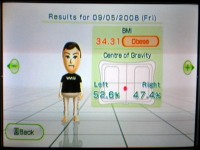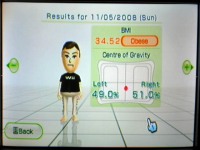I bought Wii Fit last Thursday, so it wasn’t until after work that I was able to fire it up and go through my first Body Test. Obese, it told me. A kick up the arse. I started out with the balance games that I’d seen in pre-launch promotions — soccer, skiing. Then yoga, muscle exercises, aerobics, another go at slalom. Then bed.

Day 2, and I went through the Body Test again. I’d somehow put on over a kilogram overnight. Disheartening. Wii Fit helpfully advised that your body naturally fluctuates +/- 1kg over the course of the day, so it was advisable to take the test at the same time each day for consistency. That sounded sane enough, so I decided I’d better stick with mornings. If I make Wii Fit part of my wake-up routine, I should be able to do the Body Test at roughly the same time each day. Then I can fit in some of the exercises in the morning or in the evening.

On Saturday, Day 3, I found I’d put on a touch more, but nothing major. Perhaps there is something to the fluctuation theory. Anyway, on Friday I’d eaten pretty badly: McDonald’s for breakfast, Nando’s chicken and chips for lunch, takeaway vindaloo and samosas for dinner. Plus chocolate. I was actually quite suprised not to have stacked on some weight.
I also knew that if I was going to reach my goal, I’d have to be a lot more disciplined. I was pretty good during the day on Saturday, but a family dinner at a Docklands restaurant meant beer, Coke, a huge chicken parmagiana, and a very rich icecream cone for dessert.

In the morning, Day 4, I was keen to see the damage. I lost 0.1kg. Not bad! Lesson: if I’m disciplined during the day, I can go out for a big meal and still break even. Good to know.
So that day I tried to eat smaller portions. A hash brown for breakfast, a single slice of pizza for lunch, and Pakistani lamb curry for dinner. I walked around Melbourne for an hour, but that was really my only exercise. I didn’t do my Wii Fit workout because I’d been playing Super Mario Galaxy and didn’t want to have to swap discs.

Today, Day 5, I got a bit of a surprise. I dropped 2.3kg!


The ball is rolling; let’s see if I can keep the momentum up.
Score to beat: BMI 33.8, 110.8kg.









